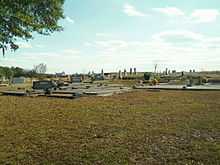Grancer Harrison

William "Grancer" Harrison (1789–1860), aka The Dancing Ghost of Grancer Harrison, is the subject of several ghost stories about his alleged spirit seen dancing at his grave-site near Kinston, Alabama. The story was featured in the book 13 Alabama Ghosts and Jeffrey[1] and is the subject of a song by country band Granville Automatic. Originally covered by a large wood-frame grave shelter, the tomb has been vandalized and rebuilt several times in the last 50 years, with the most recent vandalism at the cemetery in 2010. The tomb itself was last reconstructed in 2005.[2]
Background
Harrison was born in the old Ninety-Six District, Edgefield County, South Carolina circa 1789. He came to Coffee County, Alabama sometime in the 1830s and established a large plantation near the junction of Cripple Creek and Pea River in an area just out outside of what is now Kinston, Alabama. The Harrisons' plantation was built on a high bank overlooking Pea River. Grancer and wife Nancy had several children. They included Elizabeth, Mary, Charlotte, James M., Frances, Sarah, John A., William A., Moses M., & Martha Jane.[1][2]
The Ghost Story

The oral legend of Grancer Harrison has been edited by generations of successive story tellers to spare modern sensibilities the true nature of slavery in the age of Grancer Harrison. As seen in this extract from North Carolina, Peruvian guano had allowed for a tripling of cotton production in the South. Slavery, almost overnight, was transformed from an ugly social situation into a nightmare. By the height of Grancer Harrison's reign over his Alabama plantation, just before his death in 1860, plantations had become sprawling slave settlements. In order to contain so many people, the agrarian South had to become militarized, as seen here, with European men and boys scouring the countryside to maintain social order. Free African Americans and American slave workers now lived in a nightmarish hell, overseen by men like Grancer Harrison.
However, the story does give us a glimpse into the life of a wealthy planter who lived at the peak of agricultural production in the slave-labor-driven South as the greed of the large plantation farmers steered the South into the US Civil War. The story may be summarized as follows, 'Grancer was a successful cotton planter and is said to have owned the largest number of slaves in the county. He hosted barbecues, dances, and horse races every Saturday possible. He loved these things so much that he had his slaves build a large dance hall just for the parties he sponsored. Grancer had a pair of clogs, or dancing shoes, that he wore just for the parties he loved so well.'.[1][2] It is not difficult for modern readers to imagine today how it was for the slaves as they listened to the music and laughter late into dark nights of a brutal existence. Perhaps they listened and compared the sound to the infernal music from a story of devils and demons.
'The years passed and Harrison was faced with the fact that he would not live forever, so he began to prepare for his final arrangements. Slaves were forced to travel to the brick kiln in Milton, Florida, and return with loads of brick. Work began on the large above ground tomb he intended to be buried in. In a last act of excess, Harrison was to be buried in the tomb with his dancing clothes and his clogs on, lying on his feather bed. The burial site was within earshot of his beloved dance hall so that he could still be a part of it in some way. The end for Harrison finally came in 1860 and his burial orders were followed exactly. The Saturday night dances continued for a while but without Harrison it just wasn't the same and the dance hall soon fell into ruin.'[1][2]
'Then people began to tell tales of passing the Harrison Cemetery late on a Saturday night and hearing the eerie sounds of fiddling and dancing coming from the cemetery. Other stories had passers-by reported hearing the deep booming voice of a man calling out square dances and being accompanied by a fiddle.'[1][2]
Grancer Name Origin
Grancer Harrison would have been given his charming name, "Grancer" by his many children and grandchildren. The nickname, "Grancer" was actually very commonly given to a grandfather in the region of South Carolina from which hailed Grancer Harrison. Grancer was an affectionate term, in common use at the time by immigrants from Western Britain to the Carolinas. The term refers to a Grand Sire—which means Grand Father. http://en.wikipedia.org/wiki/Sire.'[1][2]
Vandalism

Another tale concerning Harrison's grave claimed that Grancer had a large sum of gold buried with him and still others claimed that he buried gold near the old dance hall. Vandals solved the mystery of the gold in his tomb in 1964 when they blew it open with dynamite. There was no gold and they succeeded only in destroying the tomb and scattering Harrison's skeletal remains.[2]
The Harrison Cemetery along with Harrison's Grave was again vandalized on July 30, 2010. Approximately 50 headstones were overturned.
See also
References
- ↑ 1.0 1.1 1.2 1.3 1.4 1.5 Windham, Kathryn Tucker; Figh, Margaret Gillis. (1969). 13 Alabama Ghosts and Jeffrey. The University of Alabama Press. pp. 113–120. ISBN 0-8173-0376-6.
- ↑ 2.0 2.1 2.2 2.3 2.4 2.5 2.6 Gray, Jeremy (October 30, 2005). "The Tale of the Dancing Ghost of Grancer Harrison". The Birmingham News.